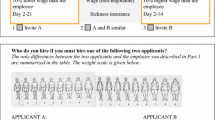Abstract
This paper considers the effects of the September 11th attacks on job attribute preferences and recruiting strategies. A survey was conducted with firms (n = 46) and college students (n = 138) in the New York, New Jersey, and Pennsylvania area. Results indicate 91% of firms believe the attack changed the job attribute preferences of students. The corresponding survey given to college students indicates that 60% of the students say the attacks would not have an impact on their preferred job attributes.
Similar content being viewed by others
REFERENCES
Barber, A. 1998. Recruiting employees: Individual and organizational perspectives. Thousand Oaks, CA: Sage.
Bartol, K.M. 1976. Relationship of sex and professional training area to job orientation. Journal of Applied Psychology, 61: 368-70.
Bergmann, T., & Taylor, M. S. 1984. College recruitment: What attracts students to organizations? Personnel, May-June: 34-46.
Bigoness, W. J. 1988. Sex differences in job attribute preferences. Journal of Organizational Behavior, 9: 139-147.
Breaugh, J.A. 1992. Recruitment: Science and practice. Boston: PWS-Kent.
Breaugh, J.A., & Starke, M. 2000. Research on employee recruitment: So many studies, so many remaining questions. Journal of Management, 26: 405-434.
Bundy, P., & Norris, D. 1992. What accounting students consider important in the job selection process. Journal of Applied Business Research, 8(2): 1-6.
Bureau of National Affairs. 1998. Recruiting and selection procedures. Personnel Policies Forum, Survey No. 146. Washington, D.C.
Butler, S. A., Sanders, D. E., & Whitecotton, S. M. 2000. Student and recruiter insights on the importance of job attributes. Journal of Managerial Issues, 12(3): 337-351.
Carlson, K., Connerley, M., & Mecham, R. 2002. Recruitment evaluation: The case for assessing the quality of applicants attracted. Personnel Psychology, 55: 461-489.
Caudron, S. 2002. Why 9/11 didn't change the workplace. Workforce, 81: 34-38.
Chew, I. & Teo, A. 1993. Job attribute preferences: The effect of gender in job choice of undergraduates. Women in Management Review, 5: 15.
Connerley, M.L., & Rynes, S. L. 1997. The influence of recruiter characteristics and organizational recruitment support on perceived recruiter effectiveness: Views from applicants and recruiters. Human Relations, 50: 1563-1586.
Fedor, D. B., Buckley, M. R., & Davis, W. D. 1997. A model of the effects of realistic job previews. International Journal of Management, 14: 211-221.
Hafer, J.C. and Hoth, C.C. 1981. Job selection attributes: employer preferences vs student perceptions. Journal of College Placement, Winter: 54-7.
Harris, M., & Fink, L. S. 1987. A field study of applicant reactions to employment opportunity. Personnel Psychology, 40(4): 765-785.
Highhouse, S. Stierwalt, S. L., Elder, A. E., & Fisher, G. 1999. Effects of advertised human resource management practices on attraction of African American applicants. Personnel Psychology, 52: 425-442.
Hom, P. W., Griffeth, R. G., Palich, L. E., & Bracker, J. S. 1998. An exploratory investigation into theoretical mechanisms underlying realistic job previews. Personnel Psychology, 51: 421-451.
Kirsch, R. J., Leathers, P. E., & Snead, K. C. 1993. Student versus recruiter perceptions of the importance of staff auditor performance variables. Accounting Horizons, 7: 4.
Konrad, A. M., Ritchie, J. E., Lieb, P., & Corrigall, E. 2000. Sex Differences and Similarities in Job Attribute Preferences: A Meta-Analysis. Psychological Bulletin, 126(4): 593-641.
Manhardt, P. J. 1972. Job orientation of male and female college graduates in business. Personnel Psychology, 25: 361-368.
Perkins, M., Kilduff, C., Huxtable, J., Wilson, K., & Cheddie, M. 2001. Recruiting. A White Paper published on the Website of The Society for Human Resource Management. http://www.shrm.org/whitepapers/documents
Poe, A. 2002. High Tech recruitment: A competitive strategy. A White Paper published on the Website of The Society for Human Resource Management. http://www.shrm.org/ whitepapers/documents
Posner, B. Z. 1981. Comparing recruiter, student, and faculty perceptions of important applicant and job characteristics. Personnel Psychology, 34(2): 329-340.
Powell, A.E. 2001. September eleventh: The days after, the days ahead. Civil Engineering, 71: 36-49.
Powell, G. N. 1991. Applicant reactions to the initial employment interview: Exploring theoretical and methodological issues. Personnel Psychology, 44: 67-83.
Rynes, S. L. 1991. Recruitment, job choice, and post hire consequences. In Dunnette MD (Ed.), Handbook of industrial and organizational psychology, 2nd ed. Palo Alto, CA: Sage.
Rynes, S., & Boudreau, J. W. 1986. College recruiting in large organizations: Practice, evaluation, and research implications. Personnel Psychology, 39(4): 729-858.
Rynes, S., & Gerhart, B. 1990. Interviewer assessments of applicant fit: An exploratory. Personnel Psychology, 43(1): 13-35.
Segal, J. A. 2001. An offer they couldn't refuse. HRMagazine, 46(4): 131-141.
Vecchio, R. P. 1995. The impact of referral sources on employee attitudes: Evidence from a national sample. Journal of Management, 21: 953-965.
Vondracek, S.J., Shimuizu, K., Schulenberg, J., Hostetler, M., & Sakayanagi, T. 1990. A comparison between American and Japanese students' work values. Journal of Vocational Behavior, 36: 274-286.
Williams, C. R., Labig, C. E., & Stone, T. H. 1993. Recruitment sources and post-hire outcomes for job applicants and new hires: A test of two hypotheses. Journal of Applied Psychology, 78: 163-172.
Wotruba, T. R., Simpson, E. K., & Reed-Draznik, J. L. 1989. The recruiting interview as perceived by college student applicants. The Journal of Personal Selling & Sales Management, 9(3): 13-25.
Zingheim, P. K., & Schuster, J. R. 2001. Winning the talent game: Total rewards and the better workforce deal! Compensation & Benefits Management, 17(3): 33-39.
Author information
Authors and Affiliations
Corresponding author
Rights and permissions
About this article
Cite this article
Lieb, P.S. The Effect of September 11th on Job Attribute Preferences and Recruitment. Journal of Business and Psychology 18, 175–190 (2003). https://doi.org/10.1023/A:1027345014369
Issue Date:
DOI: https://doi.org/10.1023/A:1027345014369




